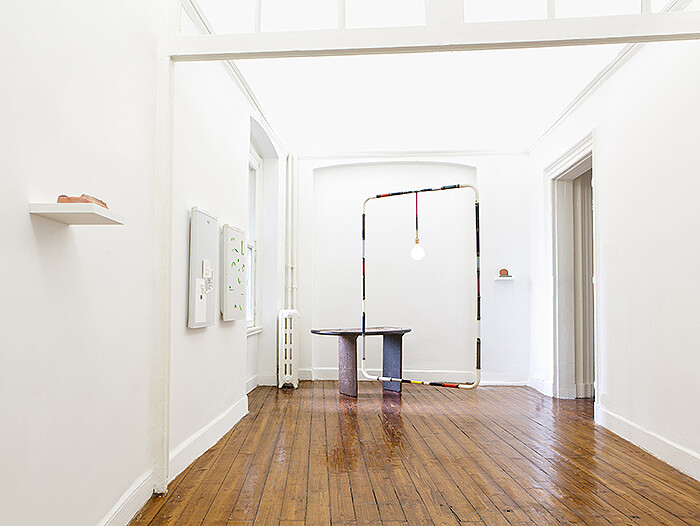November 15, 2013–February 8, 2014
As one wanders through the rooms of Rodeo’s apartment-cum-gallery space, works by eleven artists loosely connected by a low-key aesthetic make a timely statement on the condition of materiality now. Familiar media—a 16mm film, 35mm slides, paintings—are reinvented and intermixed with works fashioned from objects found in the domestic domain, including a shower curtain, refrigerator doors, and a lamp, in order to draw the viewer’s attention to the literal tangibility of sensibilities and how one makes sense of objects and space.
Upon entering the gallery, the viewer encounters Andy Coolquit’s Multi Marfa (2009)—a large lightbulb hung from the ceiling and framed by an unnecessarily large, geometrically minimal wire framework. Informing the entire exhibition, the precariousness of the metal frame hovers between the functional and the functionless. While the bulb illuminates the space with a familiar yellow glow, the structure seeming to support it is anything but “useful.”
Behind this work are Ian Law’s at 43 Kerimeikos; someplace else and at 43 Kerimeikos; kitchen décor (both works 2013), a diptych of refrigerator doors that constitutes an unlikely canvas. The absurdity of Law’s materials and their minimal aesthetic allows this domestic mise-en-scène to answer unspoken questions of intimacy and form. The left piece is populated by depictions of the cartoon character Casper the Friendly Ghost and what seems to be the gallery owner’s innocuous written request (“Can you pass the remote?”); the right piece features a scattered collection of small green tubes, hinting at a hidden syntax, like the notes and magnets found on a family’s refrigerator door.
In the short corridor outside of the first room is Tamara Henderson’s Accent Grave on Ananas (2013), a 16mm color film. Activated by motion sensor, the short loop depicts a hand removing a newly formed glass from a pineapple, which serves as its “heat-resistant” container. Audible throughout the entire space, the whimsical soundtrack is reminiscent of holidays and tropical beaches. The story is told through visual juxtaposition, similar to the work of experimental filmmaker Maya Deren, whose unfolding images are at once linear and cyclical. The film projector’s automation serves to both engage the viewer physically within the narrative and to privatize the view—introducing a kind of intimacy that runs throughout the exhibition. Taking advantage of the gallery architecture’s nooks and niches, the overall installation already belies a certain hominess, but this work introduces an additional layer of intimacy: the action of the motion sensor enhances the personal experience of approaching—walking around and towards—the work of art.
In Rey Akdoğan’s Carousel no. 6 (2011–12), color gels and filters—as well as Mylar and assorted packaging material—are squeezed into 35mm slide mounts and projected onto the wall in an adjacent room. Living, breathing, clucking away rhythmically, the slide projector produces images that one would never encounter in real life. The assemblage’s three-dimensionality is flattened into a two-dimensional projection, producing a brilliant means of approaching abstraction.
An eloquent articulation of the exhibition’s undercurrent—the familiar and intimate transformed and estranged—leaners (2013), another work by Akdoğan, is made up of three panes of glass that have been removed from the windows of the space and positioned almost haphazardly against a wall. At once displaced from their original location but still located within the parameters of the space, leaners engages with a visually, aurally, and temporally shifting architecture. Like many of the objects in the exhibition, this work is small-scale and speaks to the viewer and the other installed works in a way that is not too different from the functional spaces we normally inhabit.
In contrast, Colin Whitaker’s Teleferik (2013), a dormant kinetic sculpture, underscores the relationship between mechanics and the exhibition’s nitty-gritty materiality. Alluding to a mode of public transportation within a short distance of the gallery, its title means “cable car” in Turkish; however, Teleferik reconfigures the locomotive’s mechanics with simple materials and substitutions. Situated between the two windows on the rear side of the building, this almost moving object is divided into three distinct parts, or levels—one on the ground, one on a stool, and one on a shelf attached to the wall—all of which function like stand-ins for stations, while material not unlike that of a garden hose cleverly connects the simple metal rods together.
The title of the exhibition, which calls upon the viewers to interrogate notions of visibility, invites us to tread within a paradoxical environment that is equally uncomfortable, familiar, and intimate. As we move throughout the exhibition, our relationship to these materials becomes defamiliarized and their visibility/viewability shifts from one work to the next. “Burn These Eyes Captain, and Throw Them in the Sea!!” distorts materiality, reminding us that the mere assembly of ordinary things can be ingeniously activated under the right conditions.









